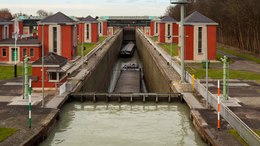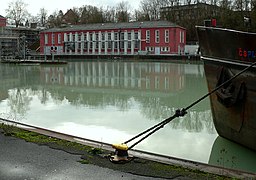Anderten lock
| Anderten lock | |
|---|---|
|
Aerial view of the Anderten lock
|
|
| Basic data | |
| Place: | Hanover , Lower Saxony , Germany |
| Location: | MLK-km 174.24 |
| Use: | Inland lock |
| Construction time: | 1919-1928 |
| Technical specifications | |
| Drop height : | 14.7 m |
| Width: | 2 × 12 m |
| Length: | 225 m |
| Lock chamber: | 40,000 m³ |
| Water consumption per lock: | 9,828 m³ |
| Duration of a lock passage: | 15 minutes |
The Anderten lock , also known as the Hindenburg lock , in Hanover-Anderten overcomes a height difference of 14.70 m between the western and the apex of the Mittelland Canal . At the time of its inauguration in 1928, it was the largest inland lock in Europe.
history
After shipping operations commenced in 1916 on the Mittelland Canal from the “ Nassen Dreieck ” (junction from the Dortmund-Ems Canal at Bergeshövede) to the Misburg harbor , construction of the largest inland lock in Europe began in 1919 east of Hanover in the then still independent village of Anderten. After the dredging work, construction began on the actual lock in 1924, which was opened on June 20, 1928 by President von Hindenburg . At the same time, shipping was released in the further course of the Mittelland Canal to Peine and on the Hildesheim branch canal . The lock was named Hindenburgschleuse in honor of the Reich President .
In the mid-1960s, the road bridge on the B 65 over the head of the lock was replaced by two new bridges south of the lock area. In 2003 it was decided to automate the lock to a large extent, by means of which the lock passage should be shortened to ten minutes.
Every year up to 22,000 ships are guided through the 225 meter long lock chambers. The next lock at the eastern end of the apex of the Mittelland Canal, in the direction of the Elbe, is the Sülfeld lock in front of Wolfsburg , which lowers the ships by 9 m. The Braunschweig Waterways and Shipping Office is responsible for the operation and maintenance of the Anderten lock .
Surname
For decades the lock was generally referred to as the Hindenburg lock. The federal government, as the owner of the waterway, uses the name "Schleuse Anderten" on the website of the Waterways and Shipping Administration, while the term "Hindenburgschleuse" can be found on the official website of the City of Hanover. In the area of the lock there is the street "Zur Hindenburgschleuse". In 2014, the city of Hanover appointed a commission to check whether people who gave their names to streets “had active participation in the Nazi regime or serious personal actions against humanity”. He suggested the renaming of the street named after Hindenburg. According to the presentation of this advisory board, Hindenburg "paved Hitler's way to power and supported all of Hitler's political measures". This could not be put into perspective by the fact that Hindenburg was "no longer in control of his decisions", because these theses have been refuted.
However, no renaming has yet been carried out as the recommendation of the commission is not binding and there is resistance from the population to the numerous recommendations for renaming.
technology
As a double lock, the lock has two lock chambers, each 225 m long and 12 m wide. The lock chambers are closed in the lower part with 86 t heavy lifting gates and in the upper part with 20 t heavy folding gates . For a filling process that takes about 15 minutes. takes 40,000 m³ of water. It is an economy sluice . Due to limited space, closed savings chambers were chosen instead of open savings basins. They lie on both sides of the chambers in the widened lock chamber walls over the entire length of the chamber on five levels, namely 2 × 25 basins per lock chamber. Each of these levels is filled or emptied via five valves, so that in the event of a valve defect, the lock passage takes a little longer, but in total approximately the same amount of water can get into the savings basin. The valves of the savings basins are controlled by valve housings (easy to recognize as towers on the photo). Six powerful pumps in a pump house ensure that around 30% of the lock water that gets from the upper water to the lower water during a lock passage is pumped back.
photos
literature
- Goetzcke: The Hindenburg lock in Anderten on the Mittelland Canal. In: Journal of the Association of German Engineers , Volume 72, No. 41 (October 13, 1928), pp. 1457–1464.
- Reich Ministry of Transport (Ed.): The Mittelland Canal , Volk and Reich Verlag, Berlin 1938.
- Waldemar R. Röhrbein : Hindenburg-Schleuse In: Klaus Mlynek, Waldemar R. Röhrbein (ed.) U. a .: City Lexicon Hanover . From the beginning to the present. Schlütersche, Hannover 2009, ISBN 978-3-89993-662-9 , p. 296.
Web links
- The lock on the website of the Waterways and Shipping Office Braunschweig
- Data and pictures at schiffundtechnik.com
- Interactive 360 ° panorama photo of the lock area
- Brief description at hannover.de
Individual evidence
- ↑ Braunschweig Waterways and Shipping Office: Anderten lock , accessed on October 3, 2015
- ↑ Excursion tips on Hannover.de: Station 1 - Hindenburgschleuse Anderten , accessed on October 3, 2015
- ↑ These ten streets are to be renamed in: Online edition of Hannoversche Allgemeine Zeitung of October 2, 2015, accessed on October 3, 2015
- ↑ Hannoversche Allgemeine Zeitung of October 2, 2015, p. 18
Coordinates: 52 ° 21 '37 " N , 9 ° 51' 53" E








